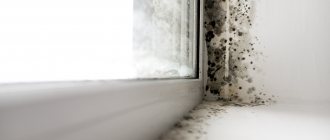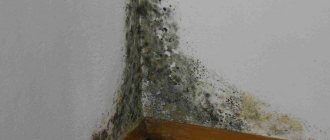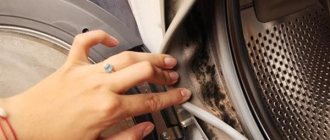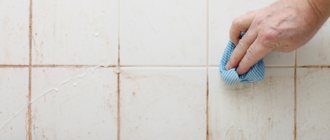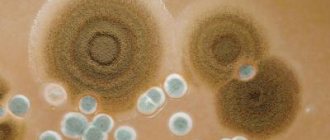Mold, or mold fungi, looks amazing under a microscope, but moldy spots on the walls are no longer so beautiful and are even dangerous to health. The musty damp smell causes discomfort. How to remove mold quickly and effectively?
Before we figure out how to deal with mold, let's get to know this ancient organism a little better. It is known that molds can exist in almost any conditions. They are not afraid of cold, heat, or radiation. Spores of these microorganisms are constantly present next to us, living unnoticed in water, soil, and air. Most often we encounter them when a food product spoils. But mold often settles on household items, clothing, wallpaper, carpet, ceiling, etc.
The color of mold can be different: gray, white, blue, green, orange. It is believed that the most dangerous is black, but any other type does no less harm if it fills more than 20% of the room.
Why is mold in the house dangerous?
In addition to the fact that mold in a room, basement, attic and other rooms destroys walls and supporting structures and spoils the appearance of a building, it is also dangerous to human health. However, many have already heard about this side of the issue. Numerous studies have been conducted, which have resulted in data that the harm of mold is absolutely real, so you should not take stains and stains on the walls lightly.
Mold spores are a powerful allergen. Contact with them is especially dangerous for people with weakened immune systems. Short-term exposure to microorganisms can cause itchy skin, symptoms of asthma and allergies, headaches, conjunctivitis, suffocating cough, and nasal congestion. With prolonged exposure, exacerbation of chronic diseases, muscle cramps, depression, abdominal pain, etc. is possible.
There is an opinion that mold can cause the development of cancer, rheumatism, chronic obstructive pulmonary disease, and infertility.
Ammonia is another effective remedy
- the method is fraught with a negative impact on human well-being;
- suitable for tiles and glass;
- high efficiency and good protection against fungus for a long time to come.
What do we have to do
- take ammonia and dilute it in water;
- clean the wall surface with the resulting solution;
- Be sure to rinse with plain water afterwards.
The advantages of this method can easily be considered an excellent foundation for the future in the fight against the most malicious fungus, but you cannot protect yourself from a serious disadvantage: since ammonia is an aqueous solution of ammonia
, a strong unpleasant odor is the first thing you will encounter. The second is irritation of the respiratory tract, headache, nausea, suffocation.
What is the cause of mold in the house?
The most important reasons for the appearance of mold: lack of quality ventilation and high air humidity (above 70-80%). Also, the growth of fungus can be affected by improperly organized heating, poor-quality processing of building materials, insufficient thermal insulation of walls, leaks in the basement, in the attic, the presence of condensation, lack of sunlight, etc.
Most often, mold appears in the basement, subfloor, on the first floor of the house, in the corner of the room, on window slopes, next to the water supply. Depending on the type of fungus, surfaces may become covered with dry and wet stripes, dark spots or a film. Over time, any material, under the influence of a growing fungus, begins to crumble or crack, and it becomes more and more difficult to remove the uninvited guest, because mold eats deep into the surface.
Removing mold is a rather labor-intensive process. Its result depends on the type of microorganisms and the degree of damage to the surface. There is no point in postponing work until later, because... fungi multiply very actively. Therefore, after eliminating the causes of mold, immediately begin treatment.
Before removing mold, equip yourself with a respirator, safety glasses and rubber gloves. Carry out all work in a well-ventilated area, removing children and pets from it.
Stationery glue
Sometimes citizens even use ordinary office glue to eliminate fungus. To do this, it is diluted in equal proportions with water, after which it is applied with a brush to the walls of the room.
This method is considered not very effective, since the substances contained in the glue can only fight certain types of mold, so they do not always cope with eliminating the fungus. Additionally, you should not use this method to treat a large affected area.
How to treat walls against fungus and mold?
You already know that mold on the walls of your home is dangerous and you need to deal with it immediately. But it's worth doing it right. Do not rush to immediately clean stains from the walls, as fresh spores will scatter throughout the room and settle on unaffected objects. It is better to treat the walls with special disinfectants before starting the procedure and only then scrape off the mold with a hard scraper or brush. Afterwards, dry the wall and ventilate the room, and then proceed to the main treatment. Special antibacterial drugs (Belinka, Well Done, Remmers Schimmel-Stop, etc.), which can be purchased in the store, will do the job well.
To enhance the effect, it is recommended to repeat the treatment after a week.
How to remove mold from a wall using folk remedies? It all depends on the degree of damage to the surface. Severe damage indicates that the fungus has ingrained itself deeply into the surface, so it will have to be destroyed with chemicals. If the stains are still small, safer mold remedies will come to the rescue.
| Mold Repellent | What surfaces is it suitable for? | Mode of application |
| Chlorine bleach | Tile, glass and other non-porous surfaces | Dilute in a ratio of 1:10, spray onto the surface or apply with a sponge |
| Hydrogen peroxide | Any surface, but before use it is worth checking on a small area, because peroxide has bleaching properties | Spray the 3% solution onto the surface or work it onto the walls using a sponge. |
| Borax (sodium salt of boric acid) | Tile, glass, wood | Dilute 1 cup in 2.5 liters of water and apply to the walls with a stiff brush. No need to rinse off. |
| Baking soda | Any surfaces | Dissolve 1 tsp. in a glass of water and spray the affected areas or wipe with a sponge. After an hour, rinse the wall with clean water. |
| Table vinegar | Any surfaces | Spray the wall, then wipe it with a sponge soaked in vinegar. After an hour, rinse the surface with clean water. |
If mold appears on the wallpaper , most likely the walls underneath are also affected. But this does not mean that we urgently need to start a grandiose renovation. First, assess the extent of the damage. If there are few spots and stains and they are localized in one place, you can try to stop the spread of the fungus. To do this, ventilate the room thoroughly and warm it up using a stove or fireplace. Then remove the mold with a soda solution (1 tsp per 1 glass of warm water). Use a soft sponge to avoid damaging the wallpaper. Then let the wall dry. There are other ways to remove mold from wallpaper: vinegar and hydrogen peroxide. Pour them into a spray bottle or apply them to a sponge, then treat the wallpaper. Then dry the wall and ventilate the room well. Just remember that peroxide can discolor the surface being treated.
If the wall is severely damaged, you will have to remove the wallpaper, spray the moldy areas and clean the wall down to the plaster. Then do the processing we mentioned above.
Armed with a bite
- copes well with almost all microorganisms;
- suitable for cleaning ordinary tableware, in 9% concentration;
- no need to dilute in water.
What do we have to do
- just soak a rag or sponge in vinegar and apply it to the wall;
- leave for an hour and then rinse with plain water;
- Be sure to dry the wall.
As you can see, everything is very simple and, as experience shows, quite effective.
How to clean mold on windows?
Mold on windows most often appears in houses where double-glazed windows are installed. They are sealed, so condensation often accumulates on the inner surface - a favorable environment for fungal growth. Mold can also appear on slopes, especially in corners. Often the problem occurs due to the fact that the windows are installed incorrectly, with cracks. Through them, moisture enters the house and promotes the growth of fungus. In this case, it is necessary to insulate the cracks and voids or reinstall the window. If the reason is improper operation, then you need to ventilate the room more often and warm the house well. In any case, mold stains must be removed immediately.
Remove the plastic trim from the slopes and the window sill (depending on the extent of the damage). Then spray the moldy areas with an anti-fungal agent or vinegar, clean and dry. After processing, you can use the same products as for the walls. Fill cracks and holes with foam. When everything is dry, install the slopes and window sill in place.
If it is difficult to overcome mold on your own, you should contact special organizations that disinfect premises.
How to get rid of mold smell?
To remove the smell of mold, you first need to find and destroy its source. Since the fungus grows almost everywhere, an unpleasant aroma can come from clothes, furniture, mattresses, and bedspreads. In this case, it is necessary to carry out general cleaning, wash things by hand, take them out into the sun and dry all textiles. Treat the furniture with undiluted vinegar, then wipe with a clean damp cloth and dry.
Don't try to mask the smell of mold with store-bought aerosols. Using them too often without eliminating the underlying cause of the odor can lead to an even greater increase in humidity in the room, and ultimately to more severe fungal damage.
It is best to freshen the air in a country house after cleaning with the help of natural essential oils , which have antifungal and disinfectant properties. To prepare this remedy for mold smell, add a few drops of oil to a spray bottle with a 5% vinegar solution and regularly spray the air in the room. Essential oils can also be applied directly to mold-treated surfaces.
You can also get rid of the unpleasant odor after removing mold using charcoal . It is enough to place several containers with it in the corners of the room - and after a couple of days the air will become noticeably fresher.
How to remove mold - preventive measures
It is also worth taking preventive measures against mold and mildew, without waiting until uninvited guests take you by surprise. First of all, pay attention to cleaning the house at the end of the summer season. After all, it is in winter, when the house is not ventilated and the humidity is higher than normal, that mold can feel like a mistress.
The best method to combat mold is to thoroughly ventilate the room.
To avoid the hassle of dealing with mold later on, be sure to consider a ventilation system. When you are at the dacha, be sure to ventilate the house, and before leaving, check the draft in the ventilation hole. Don't forget to regularly inspect water pipes and radiators. Check the condition of the windows and make sure there are no gaps, cracks or holes where moisture can get in. Also observe the following rules:
- Regularly remove debris from your roof and gutters;
- do not dry wet laundry in a country house;
- install a hood in the kitchen;
- do not fill the window sills with indoor plants, this increases the humidity in the room;
- monitor the condition of wooden parts, cover them with antifungal compounds for prevention;
- Clean regularly and wipe off dust;
- do not place furniture close to the walls, leave 2-3 cm for air circulation.
Household mold is dangerous to human health, so when you arrive at your dacha, you should immediately take measures to destroy it. Be prepared for the fact that this process will be quite lengthy and labor-intensive. And in order not to encounter a problem, be sure to take time for prevention.
Trying hydrogen peroxide
- a common means of desperately fighting fungus;
- produces a slightly whitening effect.
What should be done
- moisten the sponge in 3% peroxide;
- clean the wall surface.
Women often use this solution to dye their hair blonde. However, it can be safely used for a better cause. However, be careful: this product may leave unsightly marks on the wall of your apartment.
